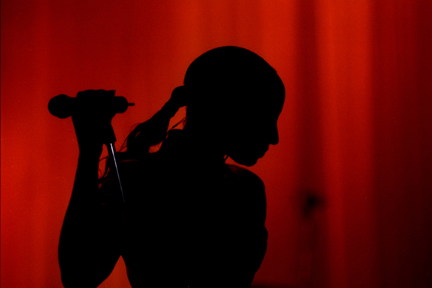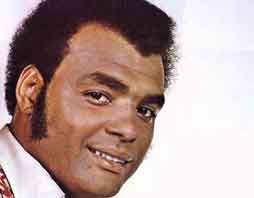SADE / “Why Can’t We Live Together”
Back in 1972, when Timmy Thomas’ “Why Can’t We Live Together” was a #1 R&B hit, it must have been the leanest, least harmonic song on the radio. Other than Thomas’ voice, there are only three sounds on the record: an electric bass, Thomas’ Hammond B3 and what sounds like a very early drum machine. Ironically, one of the most notable features of the composition almost isn’t there – that incredible bassline is mixed so badly you can hardly hear it. Thirteen years later, when Sade and Co. remade “Why Can’t We Live Together,” they made sure the bass was mixed clean, clear and upfront. They also let the bass-and-conga groove ride for over two minutes before Sade’s vocals finally come in.
On paper, the lyrics are clichés, platitudes: “No matter your color, you are still my brother,” “No more war, just a little peace,” “Tell me why can’t we live together?” etc. In the original version of the song, the potential triteness of the lyrics is trumped by Thomas’ passionate singing and the odd, stripped-down sound of the accompaniment.

In the remake, the saving grace is Sade’s cool: instead of adopting a ‘sincere’ tone (which wouldn’t have worked anyway) Sade sings Thomas’ lyrics in the same detached croon that she uses to elucidate the live and loves of all those smooth operators, heart breakers and bull fighters that populate her customary material. The incongruity between the overly sincere lyrics and Sade’s Ice Goddess vocals makes for a strange and lovely recording.
But wait! I can hear the hate now: she didn’t sing it that way for incongruity, she sang it that way because she can’t sing any other way. To which I say, maybe that’s true. And maybe I don’t care. If I could do any one thing as well as Sade does her one thing, I wouldn’t do anything else either.
—Mtume ya Salaam
Click here to purchase Diamond Life
I lean toward the original
Mtume, I hear you on digging Sade, however, I lean toward the original on this one. Yeah the bass line is forward, but the rhythmic momentum of the original is a horse of a different mule—as simple as it sounds, that’s actually a complex little syncopation that generates an ironic excitement, ironic in that when it starts up, the song hardly seems to be something to get bucked about, but as it progresses, in it’s own odd way, it rocks.
Part of what is happening is the utter sincerity of it. I wonder, from what garage sale did Timmy Thomas get those cheesy effects? And yet, as amateur as the instrument sounds, it works. Thomas probably spent every penny he could scrap, borrow and steal to make his record. This was his shot and he was going to take it, don’t care if he ain’t had but half of a drum machine that was only partially working—the drum breaks are more like stumbles than honest to goodness rolls.

On the other hand, Timmy’s organ solo is strong, much, much stronger than any of the instrumental work on Sade’s version, which is not surprising when we consider that Thomas had played gigs as a pianist backing jazz trumpeter Donald Byrd as well as the renowned Cannonball Adderley. So in the absence of a big budget and top notch studio equipment, Thomas had sincerity and the expertise of a journeyman jazz professional; that’s a hard combination to beat.
My preference for the original notwithstanding, I remain a huge supporter of Sade. Her musical talents are obvious, but what I dig the most is her personal integrity. While others complain about the paucity of her recorded output over the years, or else gossip about her six or seven year hiatus from performing, one thing I know for sure: she withstood immense pressure from the recording industry.
Sade deserves at least seven zillion write ups for successfully resisting the lucrative temptation to pump out more of the same at a faster and faster rate, and thereby ensure that the body of her life-work would forever be scarred by drivel, absurdities and, most depressing of all, absolutely dull and forgettable recordings that her body did but from which her spirit was totally disengaged.
—Kalamu ya Salaam
Can't stop. Won't stop.
I'd found an excellent interview with Thomas wherein he recounts the details of the recording of his hit record. The gist of it was that the recording was done on a shoestring budget which Thomas himself paid. The engineer let him get plugged in, said, "Ready?" and hit record. Thomas said that he recorded the song in only a little more time than it takes to actually play it back. One take. No mix. Wrap it. He got it played on a segment that a local radio station had in which they played a song each week by a local artist. The station got so many callbacks that they kept playing it. By virtue of the airplay, a local label owner (his name escapes my flood-ridden memory, but it was a well-known, nationally-distributed indie label) offered Thomas a distribution deal and the rest, as they say…I won't say it. You know the rest.
BTW, as I alluded to above, I don't have access to my own hard drive or web links; I'm writing this from the bedroom of a friend in Austin, TX. As anyone who owns a TV or a radio knows, New Orleans is soaking and burning, people are dying, the whole nine. Next week, we'll do full write-ups on the Flood of '05—Kalamu's personal experience, my personal experience and a third piece on the city itself. Some context, if you will. An attempt to add depth and breadth to the pictures we've all seen over and over. There's a lot about our city that never gets seen, that never gets said. I can't speak for Kalamu, but I don't intend to rant or rage—that's going to get done a lot. Instead, I'm going to talk about the culture, the beauty, the soul and the heart of New Orleans that is, as we speak, being bussed, airlifted, flown and driven out of the city. Those same "ugly," ignorant, poor, dirty, hungry, thirsty and, of course, Black, people you see boarding those busses to Houston, Austin, San Antonio, Dallas, Shreveport, Alexandria, Atlanta and so on are the heart and soul of New Orleans. Without them, believe it or not, there is no New Orleans. So, I'll talk about our city, and we'll listen to some music and we'll do whatever we have to do to keep on keeping on.
Won't stop. Can't stop. See y'all next week.
—Mtume ya Salaam
This entry was posted on Sunday, September 4th, 2005 at 12:03 am and is filed under Cover. You can follow any responses to this entry through the RSS 2.0 feed. You can leave a response, or trackback from your own site.
2 Responses to “SADE / “Why Can’t We Live Together””
September 4th, 2005 at 4:42 pm
Never did I think either of you would stop. Breath of Life is fresh, a voice — even if it’s from the road — from the New Orleans I love, the one Kalamu, your sister Asante, others showed me. My heart breaks, I get angry, I get moody, glad to know you all and others I know are alive, going on. The music helps. A lot. Look forward to all your writings.
September 4th, 2005 at 5:40 pm
Just finished reading your comments about Timmy Thomas. The label’s owner was one by the name of Henry Stone, owner of T.K. Records in Hialeah, Florida, a surburb of Miami. Timmy recorded this song on a T.K. subsidary called Glades in which a singer named Latimore also recorded the famous “Let’s Straighten It Out”and popular songs output from a one Harry Wayne Casey aka “KC and the Sunshine Band.” According to a book I have published by Billboard called the Billboard book of Number 1 R&B Hits all trhe recordings were no frills, very simple, and most were one take. I’m sure you probably already know this.
Leave a Reply
| top |